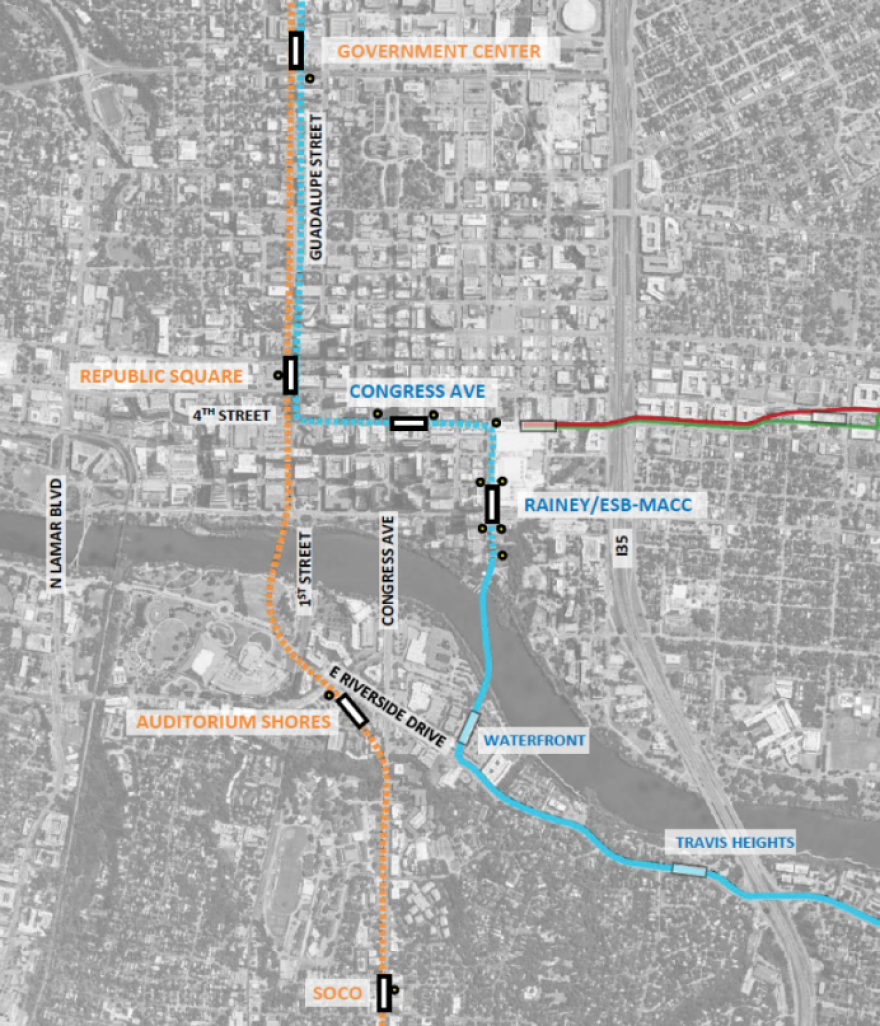Some or all of Austin’s light-rail system could be at street level downtown instead of underground, which was the vision sold to voters when they authorized Project Connect in November 2020.
The Austin Transit Partnership, a local government corporation created to build the Orange and Blue lines, is considering ways to cut costs as inflation eats into the budget for the multibillion-dollar system.
“Whether it’s underground, at-grade, potentially sections being elevated, we don’t know what the solution is yet, but we’re looking at it as much as we can to be able to present options to the public,” Peter Mullan, ATP’s chief of architecture and urban design, told KUT.

Austin Transit Partnership. This slide from an ATP presentation shows the area where light-rail tracks could be put at street level, underground or be elevated.
Early estimates for light rail pegged the price tag at $5.8 billion, accounting for most of the $7.1 billion plan voters greenlighted when they authorized a new tax of 8.75 cents per $100 of property valuation.
But rising costs for building materials, labor and property seizures – along with design changes like extending the tunnel deeper into South Austin – swelled the estimate to over $10.3 billion. And that was back in April. Costs have grown since then, but ATP hasn’t released an estimate publicly.
Other possibilities for cost-cutting include reducing the number of crossings over Lady Bird Lake from two to one. The latest plans show the Orange and Blue lines crossing the lake separately and meeting up at Republic Square Park. An alternative under consideration would see the rail lines meet on the south side of the lake and share a single crossing.

Austin Transit Partnership. This ATP map from the summer shows where light-rail lines would cross Lady Bird Lake. The map shows stations at or near Auditorium Shores, Rainey Street, Congress Avenue at Fourth Street, Republic Square Park, the Texas Capitol Complex and South Congress Avenue.
The proposal to eliminate a lake crossing could scramble the public conversation. Plans were already in the works to demolish and rebuild the Waller Creek Boathouse to make way for a tunnel portal on the north side of Lady Bird Lake. Meanwhile, ATP had been hoping to build a consensus by the end of the year on whether to spend an extra $60 million to allow buses on the rail bridge.

Nathan Bernier/KUT. The Waller Creek Boathouse at 74 Trinity St. had been slated for demolition to make way for a portal to an underground transit tunnel. Those plans are now up in the air.
The Austin Transit Partnership is even looking at reducing the length of station platforms or relocating stations entirely, something that would likely be unavoidable if the tracks were at street level downtown.
ATP could also take longer to build Project Connect, which would allow the dedicated property tax to generate more money. Under current estimates, both light-rail lines are scheduled to be up and running by 2029.
A decision on how to change the scope and timing of Project Connect isn’t expected until late spring, possibly not until June, ATP officials said at a board meeting Wednesday. The public will have a chance to weigh in before then.
At least one board member is calling on ATP to be more blunt in communicating changes to Project Connect.
“We need to be sure that we’re managing expectations in the community,” said Tony Elkins, an ATP board member with experience financing multibillion-dollar transit projects. “Because in the environment we’re in, we’re not going to be able to build everything that we thought we could build.”
This story was produced as part of the Austin Monitor’s reporting partnership with KUT.
The Austin Monitor’s work is made possible by donations from the community. Though our reporting covers donors from time to time, we are careful to keep business and editorial efforts separate while maintaining transparency. A complete list of donors is available here, and our code of ethics is explained here.



